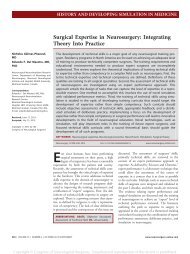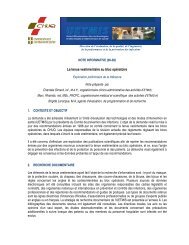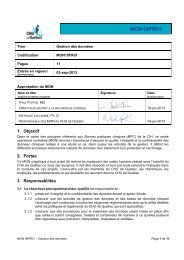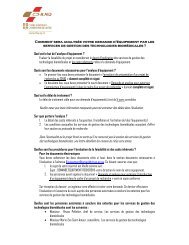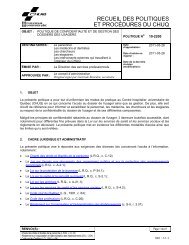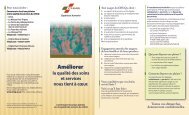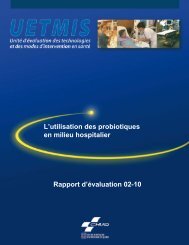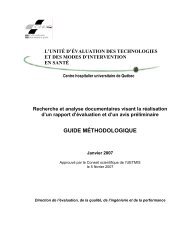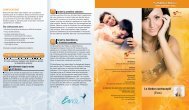intergenerational contractions of the CTG repeat - ResearchGate
intergenerational contractions of the CTG repeat - ResearchGate
intergenerational contractions of the CTG repeat - ResearchGate
You also want an ePaper? Increase the reach of your titles
YUMPU automatically turns print PDFs into web optimized ePapers that Google loves.
INTERGENERATIONAL CONTRACTION OF THE <strong>CTG</strong> REPEATS IN 2FAMILIES WITH MYOTONIC DYSTROPHY TYPE 1Jack Puymirat, Yves Giguère, Jean Mathieu and Jean-Pierre BouchardNeurology 2009;73;2126-2127DOI: 10.1212/WNL.0b013e3181c677e1This information is current as <strong>of</strong> January 5, 2010The online version <strong>of</strong> this article, along with updated information and services, islocated on <strong>the</strong> World Wide Web at:http://www.neurology.org/cgi/content/full/73/24/2126Neurology® is <strong>the</strong> <strong>of</strong>ficial journal <strong>of</strong> <strong>the</strong> American Academy <strong>of</strong> Neurology. Published continuouslysince 1951, it is now a weekly with 48 issues per year. Copyright © 2009 by AAN Enterprises, Inc.All rights reserved. Print ISSN: 0028-3878. Online ISSN: 1526-632X.Downloaded from www.neurology.org at CHUQ PAV ST FRANCOIS D'ASSISE on January 5, 2010
carrying a splice acceptor site mutation (IVS9-2AT) inALS2 causes infantile-onset ascending spastic paralysis(IAHSP). Neurogenetics 2009;10:59–64.5. Mintchev N, Zamba-Papanicolaou E, Kleopa KA, et al. Anovel ALS2 splice-site mutation in a Cypriot juvenileonsetprimary lateral sclerosis family. Neurology 2009;72:28–32.6. Kress JA, Kuhnlein P, Winter P, et al. Novel mutation in<strong>the</strong> ALS2 gene in juvenile amyotrophic lateral sclerosis.Ann Neurol 2005;58:800–803.7. Eymard-Pierre E, Yamanaka K, Haeussler M, et al. Novelmissense mutation in ALS2 gene results in infantile ascendinghereditary spastic paralysis. Ann Neurol 2006;59:976–980.Jack Puymirat, MD, PhDYves Giguère, MD, PhDJean Mathieu, MD, MScJean-Pierre Bouchard,MD, FRCPCINTERGENERATIONAL CONTRACTION OF THE<strong>CTG</strong> REPEATS IN 2 FAMILIES WITH MYOTONICDYSTROPHY TYPE 1Myotonic dystrophy type 1 (DM1) is an autosomaldominant multisystemic disorder caused by <strong>the</strong> expansion<strong>of</strong> an unstable <strong>CTG</strong> trinucleotide <strong>repeat</strong> atchromosome region 19q13.3. 1 The number <strong>of</strong> <strong>CTG</strong><strong>repeat</strong>s is unstable in <strong>the</strong> abnormal range and usuallyincreases in size in successive generations, in associationwith anticipation. 2,3 A decrease in <strong>the</strong> <strong>CTG</strong> <strong>repeat</strong>size during transmission from parents to childcan also occur in about 6.4% <strong>of</strong> transmissions,most frequently during paternal transmissions(10%). 4 In <strong>the</strong> French-Canadian DM1 population,<strong>intergenerational</strong> <strong>contractions</strong> occur in about7.4% <strong>of</strong> transmissions, all in cases <strong>of</strong> paternaltransmission. We report here 2 French-CanadianDM1 families with paternal transmission, bothoriginating from <strong>the</strong> Saguenay-Lac St-Jean, inwhich all affected children display <strong>CTG</strong> <strong>contractions</strong>.Although it was already reported that <strong>intergenerational</strong><strong>contractions</strong> could be observed inseveral sibs in a same family, it was not notedwhe<strong>the</strong>r this occurred in all affected sibs. 4 Overall,<strong>the</strong>se observations support <strong>the</strong> existence <strong>of</strong> a paternalfactor that prevents <strong>CTG</strong> expansion.Case reports. The pedigree <strong>of</strong> <strong>the</strong> 2 families andSou<strong>the</strong>rn blot analysis are shown in <strong>the</strong> figure.Family A. No clinical information was available forI-1. II-4 was diagnosed with DM1 at age 38. He had<strong>the</strong> classic manifestations <strong>of</strong> <strong>the</strong> disease with distalmuscle weakness and wasting, myotonia, and cataracts,with a Muscular Impairment Rating Scale(MIRS) <strong>of</strong> 3. 5 Molecular analysis by Sou<strong>the</strong>rn blotrevealed a <strong>CTG</strong> <strong>repeat</strong> size <strong>of</strong> about 500. His son anddaughter were evaluated at age 32 and 36. The sonFigureFamily tree and Sou<strong>the</strong>rn blotPedigree <strong>of</strong> family (A, B). (C, D) Sou<strong>the</strong>rn blot analysis. The DNA (3–5 g) was digested with EcoRV/HindIII, electrophoresed on 0.8% agarose gels, transferredonto nylon membrane (Hybond, Amersham), and probed overnight with radiolabeled FNU428 probe, as previously described. 7 The sizes <strong>of</strong> hybridizedfragments were determined from <strong>the</strong> autoradiographs containing <strong>the</strong> 1 kb DNA ladder (N32325, New England Biolabs) as markers.2126 Neurology 73 December 15, 2009Downloaded from www.neurology.org at CHUQ PAV ST FRANCOIS D'ASSISE on January 5, 2010
had myotonia and hypersomnia but no muscle weakness,whereas <strong>the</strong> daughter was clinically asymptomatic,with an MIRS <strong>of</strong> 1. Molecular analysis revealeda <strong>CTG</strong> <strong>repeat</strong> size <strong>of</strong> 360 and 260 <strong>repeat</strong>s for <strong>the</strong>son and <strong>the</strong> daughter. The bro<strong>the</strong>r <strong>of</strong> II-4, II-5was diagnosed with DM1 at age 48. He had muscleweakness and wasting, myotonia, a first-degreeheart block, and cataracts, which had been extractedat age 30. The MIRS was 4. Molecularanalysis revealed a <strong>CTG</strong> <strong>repeat</strong> size <strong>of</strong> 630. His sonand daughter were diagnosed with DM1 at age 25and 27. Both were clinically asymptomatic, with aMIRS <strong>of</strong> 1. Molecular analysis revealed a <strong>CTG</strong><strong>repeat</strong> size <strong>of</strong> 260 <strong>repeat</strong>s for both children. A newevaluation <strong>of</strong> <strong>the</strong> daughter at age 42 revealed thatshe was still clinically asymptomatic.Family B. I-1 was diagnosed with DM1 at age 50.He had <strong>the</strong> classic manifestations <strong>of</strong> <strong>the</strong> disease withdistal muscle weakness and wasting, myotonia, cataracts,and an MIRS <strong>of</strong> 3. Molecular analysis revealeda <strong>CTG</strong> <strong>repeat</strong> size <strong>of</strong> 500. I-1 had 4 affected childrenwho were diagnosed with DM1 at age 30, 34, 35,and 36. All were clinically asymptomatic with anMIRS <strong>of</strong> 1. Molecular analysis revealed a <strong>CTG</strong><strong>repeat</strong> size <strong>of</strong> 250 for all 4 children. Subjects II-5and II-6 both have 2 affected children. All wereclinically asymptomatic with a <strong>CTG</strong> <strong>repeat</strong> size <strong>of</strong>210 at age 10 (III-9), 5 (III-10), 7 (III-12), and 5(III-13).Discussion. We report 2 DM1 families with paternaltransmission in which a <strong>CTG</strong> <strong>repeat</strong> size contractionwas observed in all affected descendants. Infamily A, <strong>the</strong> contraction was observed in all affectedchildren from 2 branches and, in family B, a contractionwas observed in all affected children and hasremained stable in <strong>the</strong> next generation. There is onlyone reported case in which a <strong>CTG</strong> <strong>repeat</strong> size contractionin one child was associated with a concomitantexpansion in <strong>the</strong> bro<strong>the</strong>r, during paternaltransmission. 6 In this latter study, however, a possiblebias may exist because <strong>of</strong> <strong>the</strong> weak differences in<strong>the</strong> size <strong>of</strong> <strong>the</strong> <strong>CTG</strong> <strong>repeat</strong>s between <strong>the</strong> fa<strong>the</strong>r and<strong>the</strong> children (833 for <strong>the</strong> fa<strong>the</strong>r and 500, 667, and1,000 for <strong>the</strong> children) and because <strong>the</strong> molecularanalysis was performed at different times.This observation raises <strong>the</strong> possibility that, incases <strong>of</strong> paternal transmission, when a contraction isobserved in a sibling, <strong>intergenerational</strong> <strong>contractions</strong>could be observed in all affected sibs, in differentbranches <strong>of</strong> <strong>the</strong> same family, and could remain stableacross fur<strong>the</strong>r generations. Because this is <strong>of</strong> majorimportance for genetic counseling, this needs to beconfirmed in a large number <strong>of</strong> similar families.From <strong>the</strong> Departments <strong>of</strong> Human Genetics (J.P.) and Medical Biology(Y.G.), Centre Hospitalier Universitaire de Quebec; NeuromuscularClinic (J.M.), Carrefour de Santé de Jonquière, Quebec; and<strong>the</strong> Department <strong>of</strong> Neurological Sciences (J.-P.B.), Hôpital del’Enfant-Jésus, Quebec, Canada.Disclosure: Dr. Puymirat reports no disclosures. Dr. Bouchardserved on a scientific advisory board for Merck Serono; served as aconsultant for Teva Pharmaceutical Industries Ltd.; and has receivedresearch support from San<strong>of</strong>i-Aventis and Biogen Idec. Drs.Mathieu and Giguere report no disclosures.Received January 12, 2009. Accepted in final form September 23, 2009.Address correspondence and reprint requests to Dr. Jack Puymirat,Department <strong>of</strong> Human Genetics, CHUQ, 2705 Blvd Laurier,Quebec, G1V4G2, Canada; Jack.Puymirat@crchul.ulaval.caCopyright © 2009 by AAN Enterprises, Inc.1. Harper PS. Myotonic Dystrophy. London: W.B. Saunders;2001.2. Hunter A, Tsilfidis C, Mettler G, et al. The correlation <strong>of</strong>age <strong>of</strong> onset with <strong>CTG</strong> trinucleotide <strong>repeat</strong> amplificationin myotonic dystrophy. J Med Genet 1992;29:774–779.3. de Die-Smulders CE, Höweler CJ, Mirandolle JF, et al.Anticipation resulting in elimination <strong>of</strong> <strong>the</strong> myotonic dystrophygene: a follow up study <strong>of</strong> one extended family.J Med Genet 1994;31:595–601.4. Ashizawa T, Anvret M, Baiget M, et al. Characteristics <strong>of</strong><strong>intergenerational</strong> <strong>contractions</strong> <strong>of</strong> <strong>the</strong> <strong>CTG</strong> <strong>repeat</strong> in myotonicdystrophy. Am J Hum Genet 1994;54:414–423.5. Mathieu J, Boivin H, Meunier D, Gaudreault M, Bégin P.Assessment <strong>of</strong> a disease-specific muscular impairment ratingscale in myotonic dystrophy. Neurology 2001;56:336–340.6. López de Munain A, Cobo AM, Sáenz A, et al. Frequency<strong>of</strong> <strong>intergenerational</strong> <strong>contractions</strong> <strong>of</strong> <strong>the</strong> <strong>CTG</strong> <strong>repeat</strong>s inmyotonic dystrophy. Genet Epidemiol 1996;13:483–487.7. Arsenault E, Prevost C, Lescault A, Laberge C, Puymirat J,Mathieu J. Clinical characteristics <strong>of</strong> myotonic dystrophytype 1 patients with small <strong>CTG</strong> expansions. Neurology2006;66:1248–1250.H. Cario, MDH. Bode, MDK.-M. Debatin, MDT. Opladen, MDK. Schwarz, MDSupplemental data atwww.neurology.orgCONGENITAL NULL MUTATIONS OF THEFOLR1 GENE: A PROGRESSIVE NEUROLOGICDISEASE AND ITS TREATMENTFolate-receptor alpha (FOLR1) is <strong>of</strong> central importancefor folate transport across <strong>the</strong> blood–brain barrier via<strong>the</strong> choroid plexus. Autoantibodies against folate receptorswere identified as <strong>the</strong> cause <strong>of</strong> <strong>the</strong> infantile-onsetcerebral folate deficiency (CFD) syndrome. 1 In addition,FOLR1 is important for neural tube closure duringembryogenesis. 2,3 Here we report siblings withcompound heterozygosity for 2 FOLR1 mutationscausing congenital CFD.Clinical presentation. A 5-year-old boy developednormally until <strong>the</strong> age <strong>of</strong> 30 months. Thereafter,resting and intention tremor evolved, followed byataxia, progressive speech disturbances and loss <strong>of</strong>motor capabilities, general hypotonia, apathy, andNeurology 73 December 15, 2009 2127Downloaded from www.neurology.org at CHUQ PAV ST FRANCOIS D'ASSISE on January 5, 2010
INTERGENERATIONAL CONTRACTION OF THE <strong>CTG</strong> REPEATS IN 2FAMILIES WITH MYOTONIC DYSTROPHY TYPE 1Jack Puymirat, Yves Giguère, Jean Mathieu and Jean-Pierre BouchardNeurology 2009;73;2126-2127DOI: 10.1212/WNL.0b013e3181c677e1This information is current as <strong>of</strong> January 5, 2010Updated Information& ServicesSubspecialty CollectionsPermissions & LicensingReprintsincluding high-resolution figures, can be found at:http://www.neurology.org/cgi/content/full/73/24/2126This article, along with o<strong>the</strong>rs on similar topics, appears in <strong>the</strong>following collection(s):All Neuromuscular Diseasehttp://www.neurology.org/cgi/collection/all_neuromuscular_disease Muscle diseasehttp://www.neurology.org/cgi/collection/muscle_disease Naturalhistory studies (prognosis)http://www.neurology.org/cgi/collection/natural_history_studies_prognosis All Geneticshttp://www.neurology.org/cgi/collection/all_geneticsTrinucleotide <strong>repeat</strong> diseaseshttp://www.neurology.org/cgi/collection/trinucleotide_<strong>repeat</strong>_diseasesInformation about reproducing this article in parts (figures, tables)or in its entirety can be found online at:http://www.neurology.org/misc/Permissions.shtmlInformation about ordering reprints can be found online:http://www.neurology.org/misc/reprints.shtmlDownloaded from www.neurology.org at CHUQ PAV ST FRANCOIS D'ASSISE on January 5, 2010



